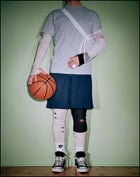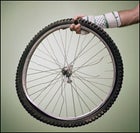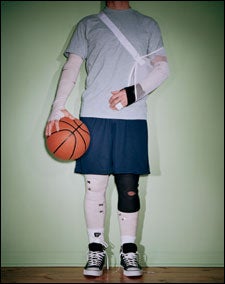COMMIT TO A SPORT and you’ve earned yourself a lifetime of fun and fitness. But if there’s one downside to your high-intensity lifestyle, it’s the potential injury looming behind every wipeout, twist, leap, or stride—the one that could put you in a La-Z-Boy for months.
Injury Recovery

That’s where our fast-fix plan comes in. We’ve put together a three-prong approach that will help you beat back the majority of bad breaks (or sprains or tears) in your sport. First, we surveyed national sports-governing bodies, medical associations such as the American College of Sports Medicine, and sports labs across the country and zeroed in on the six most common injuries afflicting thousands of pro and recreational athletes engaged in skiing, running, bicycling, basketball, climbing, and kayaking, among others. Once we had our list, we sought out the top docs and trainers in the field to prescribe innovative healing strategies to cut your time on the disabled list. Then we rounded up advice on how to avoid the carnage in the first place.
Follow our guide and you’ll keep charging hard for many years to come.
ACL Tear
Injury Recovery

» ACL Tear
“THERE’S ONE ACL INJURY for every 2,300 skiers a day during the winter,” says Dr. Robert Johnson, professor emeritus of orthopedic surgery at the University of Vermont, who estimates that he’s repaired 3,000 torn anterior cruciate ligaments (ACLs), the connective tissue that keeps the shin and thighbone properly aligned. The damage, common among skiers and basketball, volleyball, and soccer players, comes from a backward twisting fall that causes the ligament to snap. The prognosis? A trip to the OR and six months of rehab.
TREATMENT: “If your doctor says you have to have surgery—which isn’t always the case—you need to get your range of motion back before you go under the knife,” says Johnson. “Otherwise the joint could become stiff after surgery, and you may lose some range of motion permanently.”
Three times a day, take five minutes and sit on the edge of a table straightening and bending your knee as far as you can, Johnson counsels. “It should hurt while you move the leg, but not after you’re done.”
PREVENTION: When you fall and you know your knee is functional but hurtin’, don’t try to bounce back up. According to Johnson, you’ll likely fall again and tear the already stretched ACL. Instead, stay down until you know for certain everything’s OK, then limp down the mountain or off the court and call it a day.
Foot Stress Fracture
» Foot Stress Fracture
PAINFUL STRESS FRACTURES are the result of repeated force in one area, and the most common breaks show up in the small bones, called metatarsals, in the ball of the foot, and the larger tarsals, closer to the ankle. They typically occur in runners and basketball players after a sudden increase in training intensity or mileage.
TREATMENT: “Most stress fractures take at least four to six weeks to heal, and the only thing that helps is rest,” says Marje Albohm, an athletic trainer with Indianapolis, Indiana’s OrthoIndy sports-medicine clinic. “You needn’t lose your fitness, though. You can maintain it by switching to non-weight-bearing activities like swimming or biking at least three times a week.” Keep the swelling down by icing the injured foot after every workout.
Gary Briskin, a podiatrist with the Foot and Ankle Institute, in Los Angeles, says, “When you do walk around, wear stiff-soled shoes like hiking boots. They’ll protect the fracture by preventing your foot from flexing and putting pressure on the sensitive area.”
PREVENTION: Invest in quality footwear. “Good shoes disperse the force from your body’s impact evenly over the entire foot surface, so fractures have less of a chance of developing,” says Albohm. To find the best shoe for you, go to a running-shoe shop staffed with experts. Having trouble locating one? Talk to members of a running club or call the track coach at a local college or high school.
Ankle Sprain
» Ankle Sprain
TOM ABDENOUR, head athletic trainer for the NBA’s Golden State Warriors for the past 19 years, says 85 percent of the ankle sprains he’s witnessed are caused by an awkward landing that rolls the foot inward, thus stretching or tearing the ligaments that hold the ankle joint in place, and it’s not only hoopsters who are at risk. Volleyball, softball, and soccer players can also suffer. The hobbling pain pulsing from a sprain means a seat on the bench for four days up to—gulp—six weeks.
TREATMENT: “For the first 48 hours, ice and elevate the ankle until the swelling goes down,” says Abdenour. “Then speed up the rehab process by submerging the ankle in ice water for five minutes, followed by plunking it into a hot bath for five minutes, and then putting it back into the ice water—alternating between cold and hot water for 25 minutes. The heat boosts circulation, which helps healing, while the cold prevents more swelling. Finish by working on your ankle’s range of motion. Try writing out the alphabet with your foot.” Repeat daily until the ankle feels healthy and strong.
PREVENTION: “Train your body to stay balanced in awkward situations and you won’t roll an ankle,” says Abdenour. Improve your equilibrium by standing on one foot for three sets of 20 seconds, alternating feet with each set. Graduate to doing it with your eyes closed.
Tennis Elbow
» Tennis Elbow
BEFORE HE BECAME the team physician for the University of Wyoming’s athletics department, Dr. Phillip Steele was a climbing rat scrambling up the big walls of Yosemite. While there, he was no stranger to the nagging pain of lateral epicondylitis, a.k.a. tennis elbow. “It’s the most common overuse injury I see in climbers,” says Steele about this strain, which also affects the racket-sport set and mountain bikers. The injury comes from maxing out the extensor muscles that originate on the outside of the elbow or from holds that put the wrist in awkward positions.
TREATMENT: “Whenever you do something with your palms down, your extensors are working,” says Steele. “Stop playing and climbing and rest those muscles by doing as much as possible in your daily routine with your palms up: lifting grocery bags, opening drawers, pulling open doors, or hefting a gallon of milk.”
PREVENTION: “Wear neoprene sleeves to keep your elbows warm, and before you start using those extensors, warm them up,” says Steele. Here’s how to get them going: With your right wrist bent inward, lightly push on your right hand with your left. Then, over six to ten seconds, slowly straighten your right wrist, pushing against the left. Repeat with your left wrist. Alternate three times.
Dislocated Shoulder
» Dislocated Shoulder
When paddlers panic, they usually start throwing their hands over their head and reaching out for as much water as possible with their paddle to prevent themselves from rolling over. It’s at this point that the torque of pounding water on a paddle coupled with a hyperextended arm can pop the upper arm out of the shoulder socket. “Over 25 years, I’ve seen this injury scenario more than any other by a magnitude of ten,” says Chris Hipgrave, director of Olympic programs for USA Canoe and Kayak. In addition to paddlers, climbers and martial artists regularly risk hearing the dreaded pop of a shoulder gone AWOL.
TREATMENT: “Assuming you don’t need surgery for torn ligaments, you’ll be in a sling for three weeks and definitely not back in a boat for at least two months,” says Stephen Gunther, team physician for the U.S. kayak squad. After the sling comes off, “you’ve got to strengthen and tighten the rotator-cuff muscles to hold your shoulder in its socket and prevent additional dislocations,” he says. Get the job done with shoulder rotations. Stand perpendicular to a closed door, right shoulder closest to the doorknob. Wrap a bungee cord around the knob and hold it with your left hand. Keeping your left elbow bent 90 degrees, tucked into your side, and your forearm parallel to the ground, sweep the cord from right to left as far as possible. Then face the opposite direction, grab the cord with your left hand again, and sweep it from left to right. Switch arms to strengthen your other shoulder. Start with one set of 15 reps and work up to five sets.
PREVENTION: “When things start going bad,” says Hipgrave, “think about keeping your elbows tucked in and extending your torso as you reach out.”


